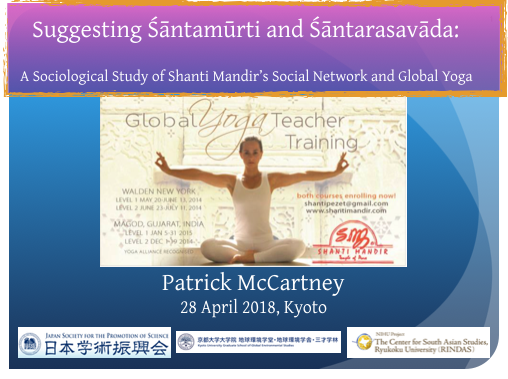Date and Time: Saturday, April 28, 2018, 14:30~17:30 hr — GMT+9
Venue: Big Meeting Room, 2nd Floor, West Hall, Omiya Campus, Ryukoku University, Kyoto, japan
We managed to have the live video feed. It was the first time I'd tried to do this. I remastered the original recording, which is available HERE.
Dr Jason Birch, from SOAS and HYP, is talking first 2:30-4:00 but his presentation is not being televised. I will talk from 4:00-5:30.
Here is some background information to the presentation.
During multiple trips between 2009–2013, I spent approximately 18-months at the Temple of Peace (Shanti Mandir) ashram in southern Gujarat, India. Initially, this was to conduct sociolinguistic research into code mixing between Hindi and Sanskrit. This is because the majority of the ashram’s residents speak Sanskrit to varying degrees of fluency, as they are either students or teachers at one of Shanti Mandir’s ‘charitable works’, which is the residential Sanskrit college, Muktānanda Saṁskṛta Mahāvidyālaya. Having successfully completed the MA in applied linguistics, I returned to Shanti Mandir as a PhD candidate to conduct an anthropologically-informed study.
I begin this presentation by discussing Shanti Mandir’s inception and history related to the schism that occurred in Baba Muktananda’s Siddha Yoga; and, how market forces, combined with the imaginative consumption of global yoga consumers, has shaped how Shanti Mandir continues to re-position itself within the multitrillion-dollar global yoga, spiritual tourism, and wellness industries.
Next, I discuss how the analytical framework evolved through noticing the recurring narrative of śānti (tranquility) that is promoted through its brand of modern soteriological yoga, Shanti Darshanam, which is facilitated by Shantarasa Yoga. This lead me to explore various aesthetic and performance-audience reception theories that build upon the ‘doctrine of appreciating tranquility’, i.e. śāntarasavāda. From which I typologise śatsaṅga (‘company of the wise’) as a hybrid campu-rasavat type of performative literature.
Following this, I discuss, from a sociology of education point of view, how Shanti Mandir’s social network is better understood as an epistemic community (of learners), and that the formal pedagogical domain of śatsaṅgaprivileges a certain type of knowledge; and, more importantly, a specific knower-disposition. This leads into a discussion of how Shanti Mandir’s global network of devotees invest various species of capital to: 1) support the guru’s vision, and 2) gain epistemological access to Shanti Mandir’s ‘legitimate yogic disposition’, which I define as śāntamūrti (‘embodier of tranquility’). Finally, I discuss the conceptual bridge created to describe the internal architecture of Shanti Mandir’s habitus.
One of the papers that I will base my presentation on is now available for free as a PDF.


